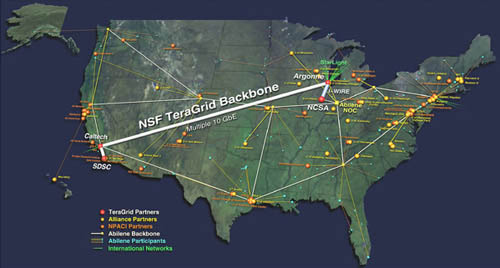GRIDtoday Interview with SDSC Director Francine Berman on TeraGrid
 |
10.22.03 - In the current edition of GRIDtoday, San Diego Supercomputer Center (SDSC) director Fran Berman talks about the progress to date on the NSF-funded TeraGrid project. The news service’s editor-in-chief, Alan Beck, began by asking how Berman, an active participant in Calit², would characterize her satisfaction with the current level of TeraGrid progress:
BERMAN: I am pleased with the current level of TeraGrid progress. It is addressing just exactly the kind of difficult issues in the construction of its hardware, software and user environment that it should. TeraGrid is an ambitious project. Everything about it pushes the envelope: the innovative storage solution, the size and coordination of the clusters, the speed of the network, the level of scale for software integration, the level of integration of operations to provide a uniform environment for users, etc. The TeraGrid team has learned an amazing amount over the last two years about putting together a national, coordinated, production Grid infrastructure. The project has bridged boundaries between many traditionally independent groups: production staff and development staff, applications developers and infrastructure developers, NSF centers, DOE and NSF, etc., and the cross-institution working groups are working together very effectively. We've all learned a huge amount on the project and are making very good progress towards project goals.
Q: How are you engaging mainstream corporate America (non-High Performance Computing-vendors, that is) into supercomputing?
BERMAN: SDSC's mission is to innovate, develop and use technology to advance science. In particular, HPC is just one of many technologies that can be brought to bear to enable science and engineering advances and discoveries. SDSC science collaborators need a wide spectrum of resources and services from persistent data management, to capable tools for desktop visualization, to help with targeting simulations and other codes to terascale-level supercomputers. SDSC partners with many vendors who are not necessarily involved in HPC. We find that it's often the case that non-HPC technologies are integrated with HPC technologies to provide end-to-end support.
Q: How much of SDSC's funding comes from PACI?
BERMAN: Currently, about half of SDSC's funding comes from PACI. Much of our funding does come from NSF. Last year, SDSC participated in four out of seven large-scale ITRs as a core technology or IT infrastructure provider. This year, SDSC is participating in two out of eight large-scale ITRs. In general, our funding is for the technology or IT infrastructure component of integrated science and technology efforts. For example, last year's ITR awards include creating modern cyberinfrastructure frameworks for earth and ecological sciences (GEON and SEEK) and this year's ITRs include creating IT infrastructure to enable exploration of the evolutionary relationships between all species of living organisms in the "Tree of Life". Such projects are helping us develop and provide critical infrastructure to enable integration of data across scale and time-frame as well as supporting large-scale analysis and simulation.
Q: Peter Freeman has noted that PACI funding will go away; big changes in PACI are coming, but no one seems to know what they are. What are you doing to ensure SDSC beyond PACI?
BERMAN: SDSC has been applying the "Gretzky Rule": "Skate to where the puck will be." We think the puck will be an integrated cyberinfrastructure vision of science, technology and educational activities. For the last two years, SDSC staffers have been working hard to develop the skills most needed for cyberinfrastructure and have gained a large amount of practical experience through the design and development of domain-oriented infrastructure, large-scale Grid efforts and deep science collaborations. Projects like GEON, BIRN and SEEK (building geosciences, biology and ecology Grid infrastructures), the TeraGrid/ETF, NPACI Grid and PRAGMA projects (giving us experience with "top-down," "bottom-up," and international Grid infrastructures), and other efforts have helped SDSC staff build deep understanding and experience with core components of Grid technologies and cyberinfrastructure. We have also been exploring deeper partnerships with both users and the commercial sector. We joke that we're "living the dream" of cyberinfrastructure at SDSC, but I think in a fundamental sense, that's really true.
(This Q&A reprinted courtesy GRIDtoday at http://www.gridtoday.com/gridtoday.html.)

